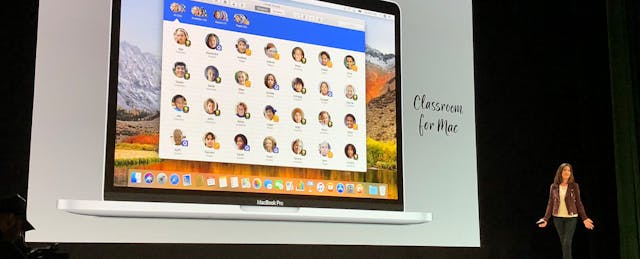“Welcome to your first day of school!” That was how bubbly Apple employees, decked out in the green-and-yellow outfits that matched the colors of Lane Tech College Prep in Chicago, welcomed arrivals to the company’s highly-anticipated education event this morning.
Attendees were given a schedule of “classes” and directed to the cafeteria for orientation. Among the 1,000 present were former vice president Al Gore, Illinois Governor Bruce Rauner, Chicago Mayor Rahm Emanuel and 300 educators from around the world.
An announcement over the PA system reminded everyone that the general assembly session was mandatory—and to not chew gum as no one is above detention. Bells signaled transitioned time between hands-on workshops led by educators.
That Apple chose this selective magnet school as the site for its latest product showcase—rather than, say, the San Francisco Moscone Center or its Cupertino headquarters—reflects the company’s renewed focus on the education market.
“We believe that our place at the intersection of technology and the liberal arts makes it possible to create and amplify our creativity,” Apple CEO Tim Cook said on stage. “This is something only Apple can do.” Throughout the speeches, presentations and product showcases, company employees and Apple touted how their tools can offer “creative” learning experiences that no others can do.

It was hardly Apple’s first day at school; the company’s education efforts trace back four decades. But once a staple—and stable—presence in the classroom, Apple’s dominance in the education market has taken a backseat. According to Futuresource, a UK market research firm, devices running the Chrome operating system accounted for close to 60 percent of all sales of mobile devices in the U.S. K-12 education market in 2017. Apple’s share made up roughly less than 20 percent—a number that trails Microsoft’s as well.
What will it take for Apple to reclaim its pole position? Indeed, the company proved rumors right by unveiling a new iPad. But Apple has never lacked for flashy gadgets. Rather, the most important updates may be upgrades to collaboration and management tools that could make those devices much easier to deploy and use.
Here’s what we saw.
First, the ‘Education’ iPad
The big announcement that caught everyone’s eye—and splattered across all the headlines—was the new 9.7-inch iPad, unveiled by Apple’s vice president, Greg Joswiak. The device retails at $329, but education purchasers can get it for $299. Among the upgrades is a 10-hour battery life, an 8-megapixel camera and increased processing power with the A10 fusion chip. Such features, he claimed, made the device more powerful than any laptop or Chromebook. That’s a not-so-subtle dig at Apple’s competitors—and the first time that the company called out Chromebooks at a keynote event.
The new iPad is also compatible with the Apple Pencil, the stylus that previously only worked with the iPad Pro. However, the Pencil must still be purchased separately—$99 for public and $89 for schools. Other add-ons showcased at the event were a new Logitech keyboard case which retails for $99 and Logitech’s own stylus, Crayon, which retails for $49.
Add all the costs up, and schools are looking at close to $500 for the new iPad with the keyboard and stylus. That cost is still steeper than Chromebooks, which start at $179. (And not to mention, Google announced yesterday its first “education tablet made for Chrome OS” that comes with a built-in stylus. The cost: $329.)
There were rumors leading up to the event that Apple would reduce the price of its iPads to as low as $259. That didn’t happen. Still, Brendan Kelly, an Apple Distinguished Educator who teaches at Wilson Elementary School in West Allis, Wisc. thinks the extra cost is worth it.
“The ability to create on an iPad is second to none,” Kelly said in an interview. “You’re not going to record what’s in front of you with a Chromebook. With an iPad, you can move everywhere. I don’t see anything that comes close.”

Accompanying Updates and Upgrades
In addition to the iPad, the company unveiled a slew of upgrades and apps to work in concert with the tablet. These included:
Smart Annotation for Pages: New features in iWork tap into the new functionalities with the Apple Pencil. Pages will soon feature Smart Annotation, which allows users to mark up documents and allow for teachers or peers to share feedback.
iBooks Author: The popular iBooks Author, which was previously only available on Macs, is now available for iPads though a workaround. Apple has brought iBooks Author functionality into Pages. The end result is that Students can create ibooks and use built-in collaboration features that allow them to work in groups.
Everyone Can Create: Building off of the company’s “Everyone Can Code” initiative that aims to introduce students to computer science, Apple announced a new curriculum, “Everyone Can Create.” Available this fall, this program will focus on four strands: music, video, photography, and drawing. The curriculum is not meant to be a standalone class, but rather weave these creative elements into existing classes to engage students.
Teacher Learning Center: The company also announced the launch of free, self-paced courses provide teachers guidance in implementing devices and curriculum into their instruction.
More Storage: To make sure students have enough digital space for their new creations, Apple also announced that education Apple ID account holders will enjoy an increase in their iCloud storage from 5 GB to 200 GB.
Augmented Reality Features: After the main event, attendees got to explore apps that harness augmented reality to dissect frogs and explore landscapes created on empty table tops using the iPad. Ordinary classroom walls turned into works of arts which students could examine up close to see each brush stroke.
The (Possible) Game Changer: Data in a Smoother Workflow
While the ability to create multimedia projects and experiences with iPads has been a major strength of Apple, managing how students use these devices as part of the classroom workflow has not alway been easy. The company’s strongest case to woo back educators may lie in two updates that aim to resolve these issues.

The first, Schoolwork, appears to be Apple’s response to Google Classroom. Launching in June, Schoolwork allows a teacher to send out documents and open specific apps on their students’ iPads. It also gives them visibility into what each student is working on to make sure they are on task or to provide support. The tool integrates with School Manager, which helps manage and deploy devices. It is designed to work independently of Apple’s remote device management app, Classroom.
An additional feature in Schoolwork is that teachers can assign students to a specific activity within a third-party app that is integrated with Schoolwork. That means, for example, that a teacher can direct kids to do a specific assignment within Tynker, a coding app that is one of 15 education apps currently synced with Schoolwork. These apps can also feed data back to teachers to show students’ progress.
Giving teachers a single place to see how students are performing across different third-party apps is an enticing prospect. Other edtech companies have recently rolled out solutions to aggregate data from multiple programs, including Yet Analytics and Clever’s Goals, but the ability to assign a specific activity and receive data back is unique to Apple’s Schoolwork (for now).
For other education app creators to sync with Schoolwork, Apple is inviting developers to check out ClassKit, a set of APIs that they can use to connect with Schoolwork. Mindful of the aftermath of the Facebook and Cambridge Analytica incident, Apple vice president Susan Prescott underscored on stage that any data passed is private, and that the company has made available guidance for developers to meet these privacy requirements.
Additionally, Apple highlighted the Shared iPad feature, which was released two years ago as part of its iOS 9.3 update. That change brings it up to speed with Google Chromebooks and Microsoft devices. Recognizing that not all schools have 1:1 programs, this feature allows different students to pick up any iPad and login to their unique profile and access their individual apps and files.
Final Thoughts
Apple’s vision of pushing education towards more creative thinking skills, enabled by technology, is certainly lofty. The idea behind fostering creativity in students through projects and genuine engagement with the world resonates with many educators. Unfortunately these ideals are not always aligned with the realities of an education system that still emphasizes standardized testing and compliance to rigorous academic standards.
Then there’s the simple issue of cost. Even with all of these new features announced today, the iPad’s price tag still remains high relative to its competitors—and cost cannot be ignored in districts where budgets have been slashed. This is especially true for a device without a built-in keyboard, in a world where typing remains a critical skill. It reinforces the existing notion that iPads are good as a tactile device more suitable for students too young to type—and just a nice-to-have for older ones.
While the new iPad took the spotlight, the operational improvements enabled by Schoolwork could have the most significant impact on teachers as it reduces the barriers to implementing the devices in classrooms, and allows them to assign targeted activities for students. Of course, that can be used to reinforce having students do independent work on their devices—and that may not be Apple’s ultimate vision. But it could make a compelling case for bringing iPads back to the classroom.
Correction Notice: This article has been updated from its original version. Per Apple, Schoolwork does not integrate with Classroom. iBooks Author remains Mac only, although Books functionality has been brought into Pages. And Shared iPad was originally released alongside iOS 9.3.


